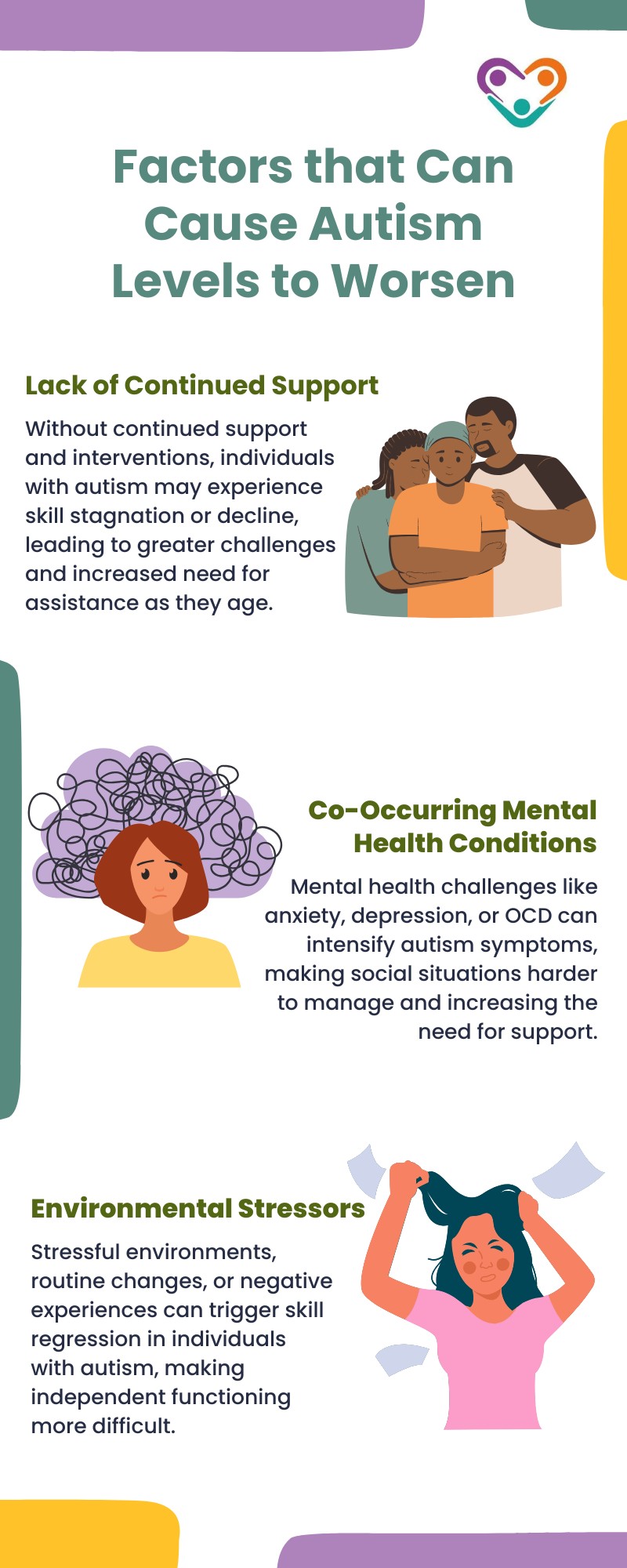One of the central aspects of understanding autism is recognizing that it exists on a spectrum, meaning the severity and type of ASD symptoms can vary greatly from person to person.
But can levels of autism change over time? This is a question that both families and clinicians often ask as they navigate the diagnosis, intervention, and development of autistic individuals.
Here, we will delve into the nuances of autism, how its severity might evolve, and the factors that influence whether levels of autism can change.
Can Levels of Autism Change?
Yes, levels of autism can change over time, but this does not mean that autism itself goes away. Autism is a lifelong neurodevelopmental condition, but the way it presents itself can evolve due to factors like age, intervention, or changes in the environment.
Some individuals may show improvements in certain areas, such as communication or social interaction, with appropriate therapies, support, and coping strategies.
Conversely, challenges might become more pronounced in other areas, especially during times of stress or major life transitions.
However, these changes do not mean a person is “less autistic” or “more autistic.” Rather, they reflect shifts in how traits are expressed or managed. For example, someone initially identified with Level 3 autism, requiring substantial support, might later appear to function with fewer supports in specific settings, while others may need more assistance as new challenges emerge.
Understanding these fluctuations underscores the importance of ongoing, individualized support.
5 Factors That Influence Change in Autism Levels
Understanding the factors that influence changes in autism levels is essential for recognizing the potential for growth and development in autistic individuals.
Several elements play a significant role in how autism manifests and evolves over time, including early intervention, access to supportive environments, individual differences, age-related developmental changes, and targeted therapeutic approaches.
Below are some key factors that can impact the level of support individuals with autism may require as they progress through life:
Early Intervention
Research consistently shows that early intervention can significantly improve outcomes for children with autism. Interventions such as Applied Behavior Analysis (ABA), speech therapy, occupational therapy, and social skills training can address specific challenges and help individuals develop important skills.
Many individuals who receive early and intensive interventions may show improvements in social communication, behavior, and adaptive functioning, which may lead to a change in the level of support they require.
Access to Supportive Environments
Supportive educational and social environments play a crucial role in an individual’s development.
Children with autism who attend schools with specialized programs or inclusive settings may have better opportunities to develop social and communication skills. This can sometimes lead to improved outcomes, especially in areas like language development and social interaction.
A supportive environment encourages autonomy, which could reduce the level of intervention required as they grow older.
Individual Differences
The course of autism varies widely from one individual to another. Some people with autism may experience significant improvements in their skills over time, while others may continue to face challenges throughout their lives.
Genetics, co-occurring conditions (such as anxiety or ADHD), and the severity of the initial symptoms can all influence how an individual’s autism manifests and how it evolves.
The idea of “changing levels” may not be applicable to everyone, but the way an individual functions in daily life can improve or worsen.

Age and Developmental Changes
As individuals with autism age, they may undergo changes in their abilities and needs. For example, a child who is nonverbal at a young age may acquire some speech skills as they grow older, which could change their level of support.
Additionally, as individuals mature, they may develop better coping strategies and social skills, leading to a greater degree of independence.
Therapeutic Approaches and Treatments
Therapies and treatments tailored to the specific needs of individuals with autism can help reduce the severity of certain symptoms and improve functioning.
For example, behavioral therapies can help autistic individuals learn to manage their behaviors and improve their social skills, possibly leading to a reduction in the level of support they need.
Similarly, medications that address co-occurring conditions such as anxiety or attention issues may help improve overall functioning.
Can Autism Levels Worsen?
While many individuals with autism can make progress over time, there are situations where the levels of autism may appear to worsen. This can happen due to various factors, such as:

The Importance of Individualized Support Plans
One of the key factors influencing whether the levels of autism change is the individualization of support. Each person with autism has unique strengths and challenges, and an approach that works for one person may not be effective for another.
Creating an individualized support plan based on the person’s specific needs is essential for fostering positive change and promoting growth.
This plan may include:
- Behavioral Interventions: ABA therapy and other behavioral therapies can target specific behaviors, social skills, and communication abilities. Tailored interventions can help individuals move toward less intensive levels of support.
- Speech and Language Therapy: For those with communication challenges, speech therapy can help improve both verbal and nonverbal communication skills, facilitating better social interaction and overall functioning.
- Educational Programs: Special education programs that focus on the strengths and challenges of individuals with autism can help them develop academic and social skills.
- Vocational Training: For individuals transitioning to adulthood, vocational training can provide essential skills for entering the workforce and living independently.
The levels of autism can change over time, but the extent of this change varies greatly from person to person. Early and ongoing interventions, supportive environments, individual differences, and developmental changes all play a role in determining whether and how an individual’s level of autism may change.
While some individuals may experience significant improvements, others may require lifelong support. The focus should be on providing individualized care and ensuring that individuals with autism have access to the resources and support they need to thrive.
Families, clinicians, and educators should work together to develop comprehensive support plans that address the unique needs of each person with autism. At Golden Care Therapy, we offer high-quality ABA therapy in Florida, New Jersey, Indiana, New York, and Georgia, tailored to help individuals thrive in their everyday lives.
Our compassionate team is dedicated to providing personalized care that makes a real difference. Contact us today to learn more about our services and how we can support your family.



